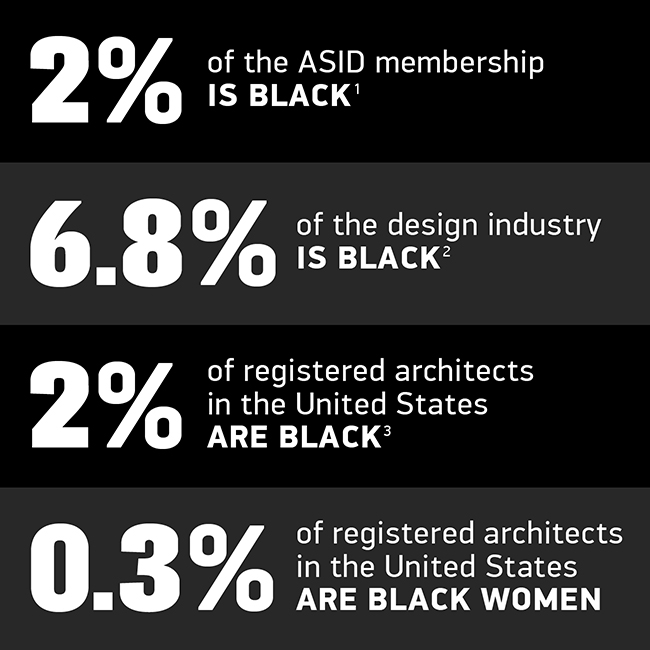A Message from Jennifer Kolstad, ASID, Assoc. AIA
Chair, ASID Board of Directors
Following the horrific killings of George Floyd, Breonna Taylor, and Ahmaud Arbery, America has finally put an emphasis on the long-endured inequities that have plagued this nation. It took a pandemic with no distractions for many of us to finally see the myriad systemic racial problems that have existed for far too long.
The question has rightfully been asked: “What is ASID doing?” following the initial statement from the ASID Board of Directors. We, like most other organizations, are desperate to contribute. Difficult problems that have systemically oppressed Black people require dedicated thinking. More importantly, they require committed solutions.
As designers, we will move forward contributing to issues of social injustice in a unified voice. We would be remiss to not mention the names of strong leaders in the ASID community who have already been doing the work and are graciously sharing their guidance and experiences with us as we make change. Denise Rush, ASID, IDEC, is a past ASID National Board member and Dean of the School of Interior Architecture at The Boston Architectural College. Kia Weatherspoon, ASID, past National Board member is a published author, a visible presence on national panels, and President of Determined By Design. Our Diversity, Inclusion and Equity task force participant Keia McSwain, ASID is Owner of Kimberly & Cameron Interiors, a successful luxury residential interior design practice, and President of the Black Interior Designers Network.
These remarkable women, and many more esteemed ASID colleagues, work in pursuit of design excellence, access to education, and issues of social justice. They are role models to our members (myself included), and the design community at large, leaning in with the full force of their brilliance to ensure diversity, inclusivity and equity. My role is to listen, learn, and act with new information in hand.
When we think about the impact design can have on Black communities in America today as a mechanism for change, we must first ask some difficult questions - how have we impacted Black communities through related topics of social justice, diversity and equity? I have personally reflected during this time to ask how I have contributed to perpetuating a system of inequality and inequity through sustaining a model of environmental outcomes designed for a class-based society. Where has the dialogue been?
The work of the ASID Foundation has brought life to research topics of autism in high school environments, active living among aging populations, mindfulness during emergency situations and many other research grants awarded over the years. But there is so much more work to be done.
In practice, interior designers bring human-centric design thinking to achieve performative outcomes. When collaborating with others, our ability to dig deep into topics described by Dr Upali Nanda, Director of HKS Research, as “big wicked problems” becomes entirely conceivable. Success is dependent upon stakeholder advocacy, community engagement, and dialogue; which only serves to further enrich our work and, in turn, us.
How much more meaningful could “Design Impacts Lives” become when influenced by and engaged with the voices of the Black community? Committing our profession and design thinking to our Black communities, Black practitioners and critical related issues will create more well-rounded practitioners who feel personally invested because they have had a voice. We must also build a much-needed pipeline of Black designers that begins with finding meaningful ways to engage traditionally overlooked communities.

Beyond the abysmal numbers, Black people in our profession face pay discrepancy as well as discrimination in the workplace.
We will all be stronger when our Society reflects the diversity and cultural richness of our communities. That said, there clearly remain issues of exposure, access, mentorship and opportunities for growth. Our Association can make change today using the following initiatives:
-
The ASID Foundation will award grants to research projects focused on diversity, inclusion, equity and social justice.
-
We will utilize the ASID Ones to Watch program, designed to elevate underrepresented minority groups into positions of leadership, to parallel path Black interior design professionals into mentorship programs.
-
We will create a program to pair our distinguished Fellows, Honorary Fellows and retired practitioners to mentor emerging Black interior design professionals throughout their careers.
-
We will earmark a scholarship fund for Black interior students, including those attending programs at Historically Black Colleges and Universities.
-
We are aligning with our allied organizations to create a stronger voice to pool resources and make a larger impact.
In our current reality that has been dramatically affected by COVID-19, our resources are limited. We need all hands on deck. We call on our chapters, members, and industry partners to build a community of sustained mentorship (up and down) to create relevance, resonance and equity for our Black interior design colleagues. Please consider volunteering your time to pair with an emerging professional as a trusted advisor and guide.
More importantly, let us collectively build an interior design profession where children can see themselves as they grow up dreaming of their future path and career.
Jennifer Kolstad, ASID, Assoc. AIA
Chair, ASID National Board of Directors
Global Design Director, Ford Motor Company
1 2020 ASID Member Census (Practitioner Members)
2 U.S. Bureau of Labor Statistics (2019)
3 National Organization of Minority Architects (2019)
